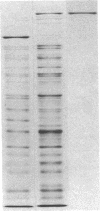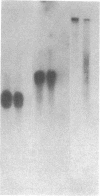Abstract
Human apolipoprotein B-100 (apo B-100) is the major apolipoprotein of low density lipoproteins and the principal ligand for interaction with the low density lipoprotein receptor. The human apo B-100 gene has been inserted into a lambda gt-11 expression vector, and the apo B-100 cDNA clones have been identified by screening with a monospecific apo B-100 antiserum, by screening with synthetic oligonucleotides based on the amino acid sequence of peptides isolated from apo B-100, and by immunoblot analysis of the expressed protein with a monoclonal antibody to apo B-100. The complete nucleotide and derived-amino acid sequence of a 1.7-kilobase cDNA clone of apo B-100 was determined. The 560-amino acid residues of apo B-100 contain no unique linear or repeating sequences of amino acids. The computer-predicted conformation of the apo B-100 protein contains segments of helical structure; however, a large portion of the protein is organized into beta-structure. The beta-structure may be important in lipid-apo B-100 interactions in low density lipoprotein and may contribute to the insolubility of delipidated apo B-100 in aqueous buffers. RNA blot hybridization analysis of liver mRNA utilizing a Nco I/HindIII apo B-100 cDNA probe revealed that the apo B-100 mRNA is 15-18 kilobases long, which is of sufficient size to code for a 250-387 kDa apolipoprotein, the proposed molecular size of delipidated plasma apo B-100. The gene for human apo B-100 has been localized to chromosome 2 by filter hybridization of human-mouse somatic cell hybrids utilizing a 400-base-pair Nco I/HindIII apo B-100 cDNA probe. This location is in contrast to the low density lipoprotein receptor that has been localized to chromosome 19. The cloning of human apo B-100 has provided new insights into the structure and physicochemical properties of apo B-100 and will facilitate studies on the factors modulating apo B-100 biosynthesis and the expression of the apo B-100 gene in patients with dyslipoproteinemias.
Full text
PDF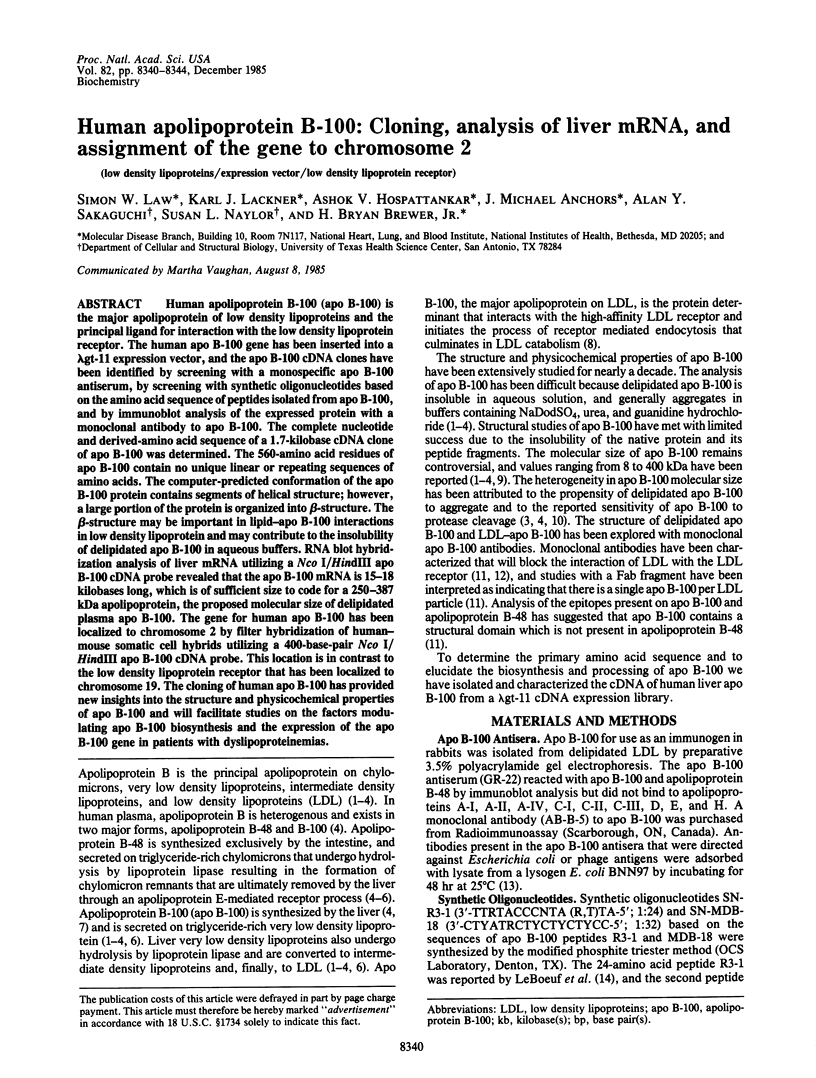
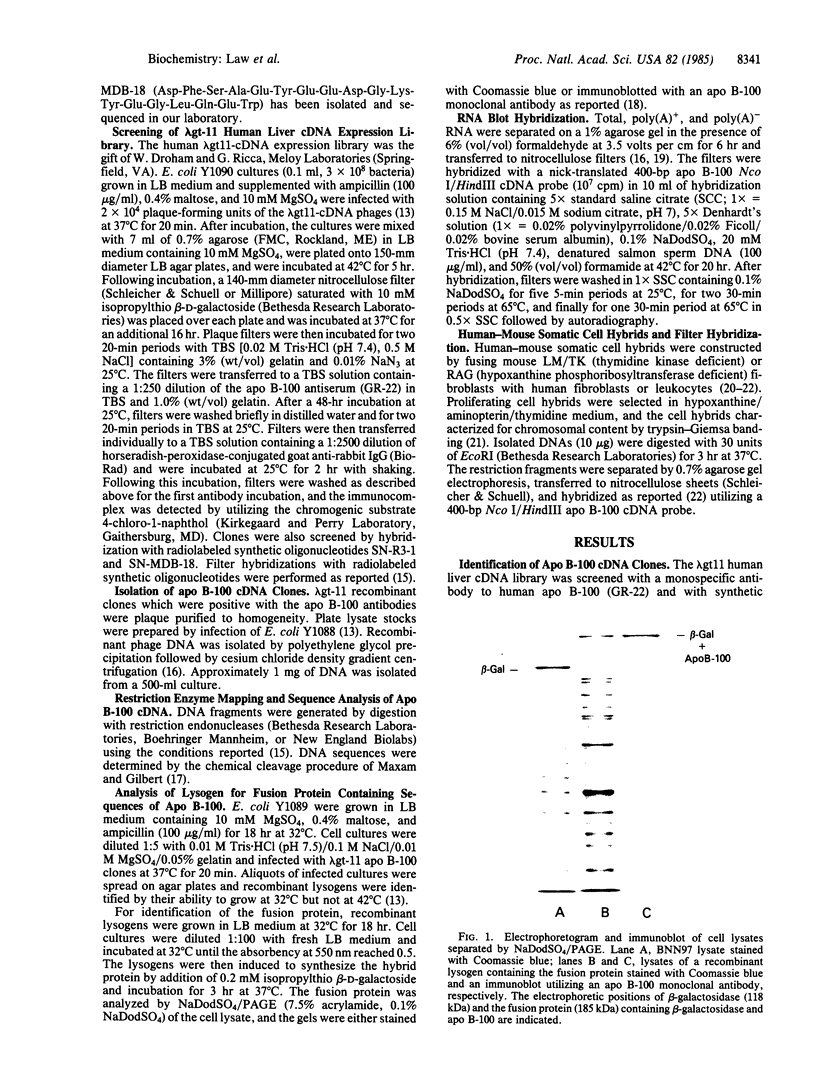
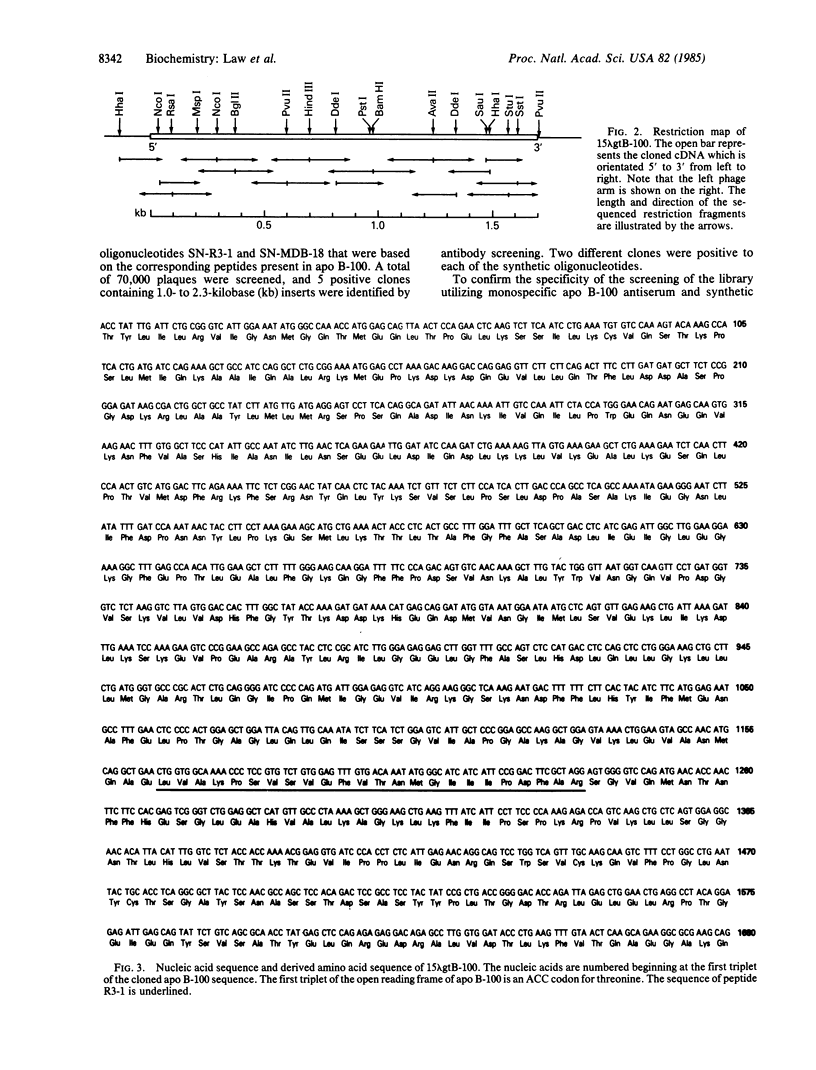
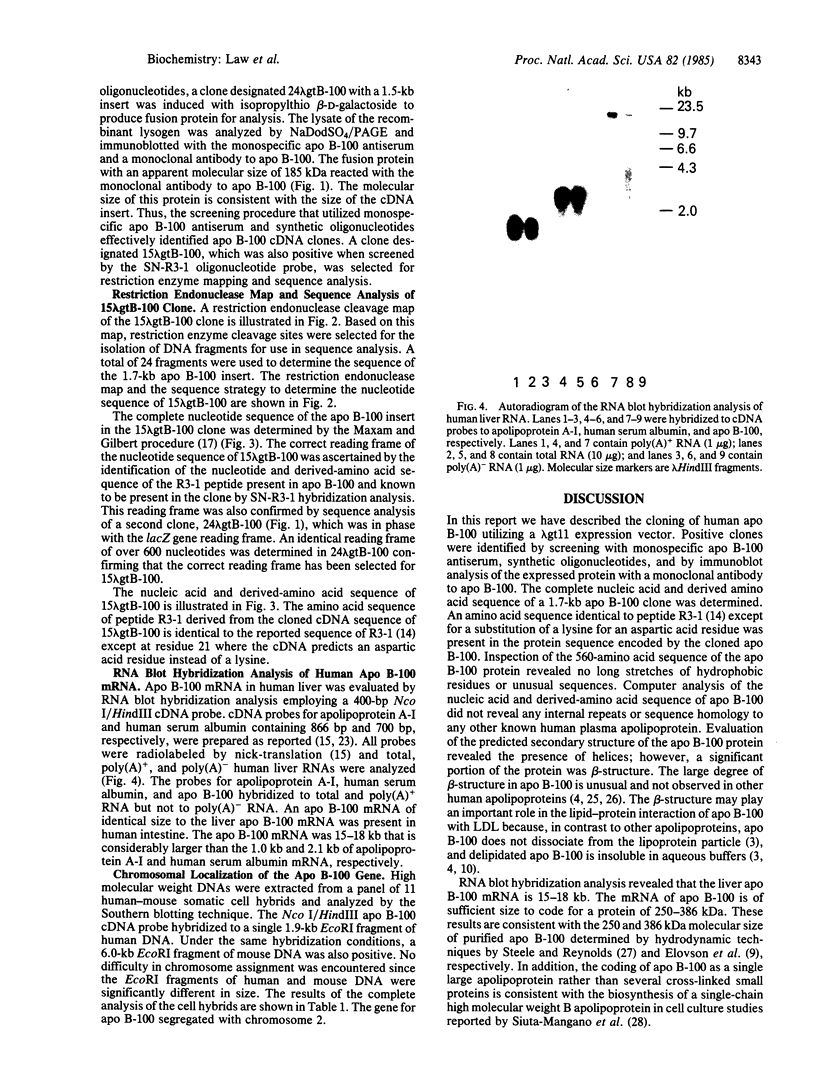
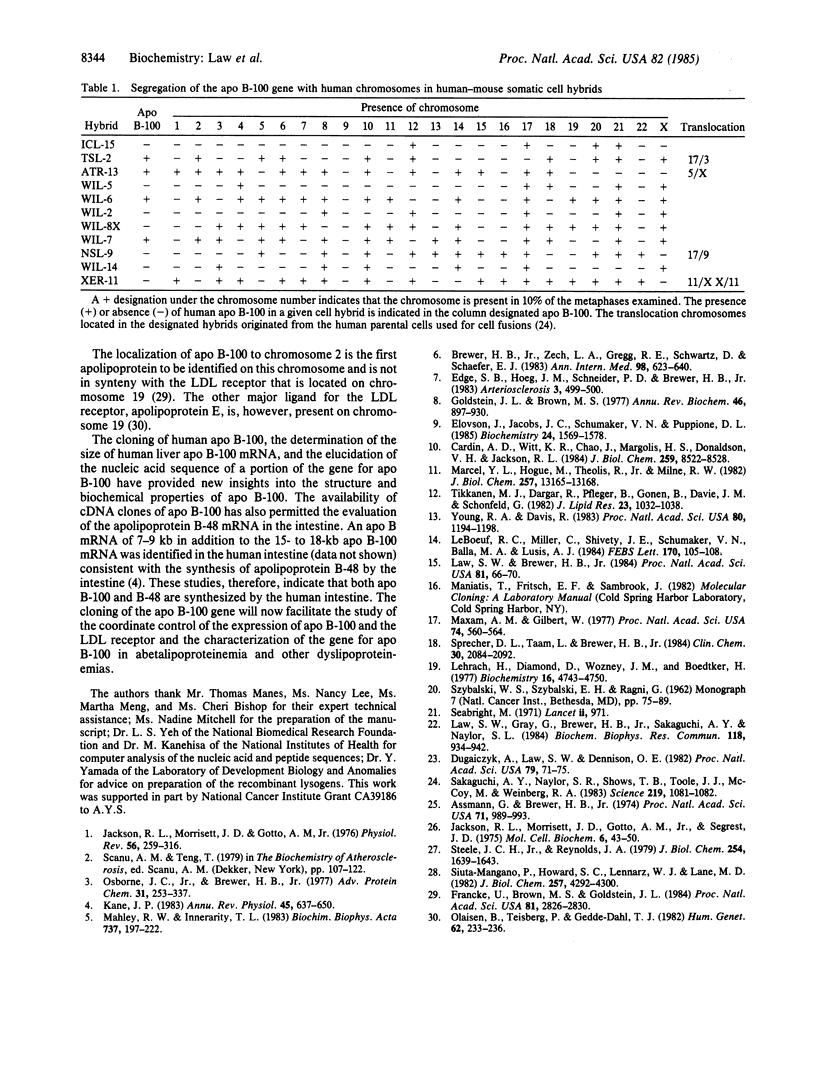
Images in this article
Selected References
These references are in PubMed. This may not be the complete list of references from this article.
- Assmann G., Brewer H. B., Jr Lipid-protein interactions in high density lipoproteins. Proc Natl Acad Sci U S A. 1974 Mar;71(3):989–993. doi: 10.1073/pnas.71.3.989. [DOI] [PMC free article] [PubMed] [Google Scholar]
- Brewer H. B., Jr, Zech L. A., Gregg R. E., Schwartz D., Schaefer E. J. NIH conference. Type III hyperlipoproteinemia: diagnosis, molecular defects, pathology, and treatment. Ann Intern Med. 1983 May;98(5 Pt 1):623–640. doi: 10.7326/0003-4819-98-5-623. [DOI] [PubMed] [Google Scholar]
- Cardin A. D., Witt K. R., Chao J., Margolius H. S., Donaldson V. H., Jackson R. L. Degradation of apolipoprotein B-100 of human plasma low density lipoproteins by tissue and plasma kallikreins. J Biol Chem. 1984 Jul 10;259(13):8522–8528. [PubMed] [Google Scholar]
- Dugaiczyk A., Law S. W., Dennison O. E. Nucleotide sequence and the encoded amino acids of human serum albumin mRNA. Proc Natl Acad Sci U S A. 1982 Jan;79(1):71–75. doi: 10.1073/pnas.79.1.71. [DOI] [PMC free article] [PubMed] [Google Scholar]
- Elovson J., Jacobs J. C., Schumaker V. N., Puppione D. L. Molecular weights of apoprotein B obtained from human low-density lipoprotein (apoprotein B-PI) and from rat very low density lipoprotein (apoprotein B-PIII). Biochemistry. 1985 Mar 12;24(6):1569–1578. doi: 10.1021/bi00327a042. [DOI] [PubMed] [Google Scholar]
- Francke U., Brown M. S., Goldstein J. L. Assignment of the human gene for the low density lipoprotein receptor to chromosome 19: synteny of a receptor, a ligand, and a genetic disease. Proc Natl Acad Sci U S A. 1984 May;81(9):2826–2830. doi: 10.1073/pnas.81.9.2826. [DOI] [PMC free article] [PubMed] [Google Scholar]
- Goldstein J. L., Brown M. S. The low-density lipoprotein pathway and its relation to atherosclerosis. Annu Rev Biochem. 1977;46:897–930. doi: 10.1146/annurev.bi.46.070177.004341. [DOI] [PubMed] [Google Scholar]
- Jackson R. L., Morrisett J. D., Gotto A. M., Jr Lipoprotein structure and metabolism. Physiol Rev. 1976 Apr;56(2):259–316. doi: 10.1152/physrev.1976.56.2.259. [DOI] [PubMed] [Google Scholar]
- Jackson R. L., Morrisett J. D., Gotto A. M., Jr, Segrest J. P. The mechanism of lipid-binding by plasma lipoproteins. Mol Cell Biochem. 1975 Jan 31;6(1):43–50. doi: 10.1007/BF01731865. [DOI] [PubMed] [Google Scholar]
- Kane J. P. Apolipoprotein B: structural and metabolic heterogeneity. Annu Rev Physiol. 1983;45:637–650. doi: 10.1146/annurev.ph.45.030183.003225. [DOI] [PubMed] [Google Scholar]
- Law S. W., Brewer H. B., Jr Nucleotide sequence and the encoded amino acids of human apolipoprotein A-I mRNA. Proc Natl Acad Sci U S A. 1984 Jan;81(1):66–70. doi: 10.1073/pnas.81.1.66. [DOI] [PMC free article] [PubMed] [Google Scholar]
- Law S. W., Gray G., Brewer H. B., Jr, Sakaguchi A. Y., Naylor S. L. Human apolipoprotein A-I and C-III genes reside in the p11----q13 region of chromosome 11. Biochem Biophys Res Commun. 1984 Feb 14;118(3):934–942. doi: 10.1016/0006-291x(84)91485-2. [DOI] [PubMed] [Google Scholar]
- LeBoeuf R. C., Miller C., Shively J. E., Schumaker V. N., Balla M. A., Lusis A. J. Human apolipoprotein B: partial amino acid sequence. FEBS Lett. 1984 May 7;170(1):105–108. doi: 10.1016/0014-5793(84)81378-2. [DOI] [PubMed] [Google Scholar]
- Lehrach H., Diamond D., Wozney J. M., Boedtker H. RNA molecular weight determinations by gel electrophoresis under denaturing conditions, a critical reexamination. Biochemistry. 1977 Oct 18;16(21):4743–4751. doi: 10.1021/bi00640a033. [DOI] [PubMed] [Google Scholar]
- Mahley R. W., Innerarity T. L. Lipoprotein receptors and cholesterol homeostasis. Biochim Biophys Acta. 1983 May 24;737(2):197–222. doi: 10.1016/0304-4157(83)90001-1. [DOI] [PubMed] [Google Scholar]
- Marcel Y. L., Hogue M., Theolis R., Jr, Milne R. W. Mapping of antigenic determinants of human apolipoprotein B using monoclonal antibodies against low density lipoproteins. J Biol Chem. 1982 Nov 25;257(22):13165–13168. [PubMed] [Google Scholar]
- Maxam A. M., Gilbert W. A new method for sequencing DNA. Proc Natl Acad Sci U S A. 1977 Feb;74(2):560–564. doi: 10.1073/pnas.74.2.560. [DOI] [PMC free article] [PubMed] [Google Scholar]
- Olaisen B., Teisberg P., Gedde-Dahl T., Jr The locus for apolipoprotein E (apoE) is linked to the complement component C3 (C3) locus on chromosome 19 in man. Hum Genet. 1982;62(3):233–236. doi: 10.1007/BF00333526. [DOI] [PubMed] [Google Scholar]
- Osborne J. C., Jr, Brewer H. B., Jr The plasma lipoproteins. Adv Protein Chem. 1977;31:253–337. doi: 10.1016/s0065-3233(08)60220-x. [DOI] [PubMed] [Google Scholar]
- Sakaguchi A. Y., Naylor S. L., Shows T. B., Toole J. J., McCoy M., Weinberg R. A. Human c-Ki-ras2 proto-oncogene on chromosome 12. Science. 1983 Mar 4;219(4588):1081–1083. doi: 10.1126/science.6823569. [DOI] [PubMed] [Google Scholar]
- Seabright M. A rapid banding technique for human chromosomes. Lancet. 1971 Oct 30;2(7731):971–972. doi: 10.1016/s0140-6736(71)90287-x. [DOI] [PubMed] [Google Scholar]
- Siuta-Mangano P., Howard S. C., Lennarz W. J., Lane M. D. Synthesis, processing, and secretion of apolipoprotein B by the chick liver cell. J Biol Chem. 1982 Apr 25;257(8):4292–4300. [PubMed] [Google Scholar]
- Sprecher D. L., Taam L., Brewer H. B., Jr Two-dimensional electrophoresis of human plasma apolipoproteins. Clin Chem. 1984 Dec;30(12 Pt 1):2084–2092. [PubMed] [Google Scholar]
- Steele J. C., Jr, Reynolds J. A. Molecular weight and hydrodynamic properties of apolipoprotein B in guanidine hydrochloride and sodium dodecyl sulfate solutions. J Biol Chem. 1979 Mar 10;254(5):1639–1643. [PubMed] [Google Scholar]
- Tikkanen N. J., Dargar R., Pfleger B., Gonen B., Davie J. M., Schonfeld G. Antigenic mapping of human low density lipoprotein with monoclonal antibodies. J Lipid Res. 1982 Sep;23(7):1032–1038. [PubMed] [Google Scholar]
- Young R. A., Davis R. W. Efficient isolation of genes by using antibody probes. Proc Natl Acad Sci U S A. 1983 Mar;80(5):1194–1198. doi: 10.1073/pnas.80.5.1194. [DOI] [PMC free article] [PubMed] [Google Scholar]



